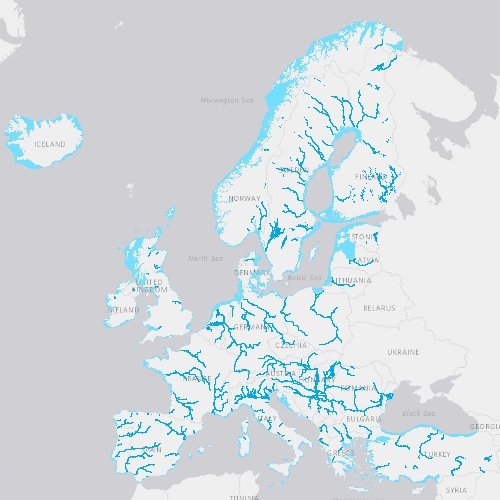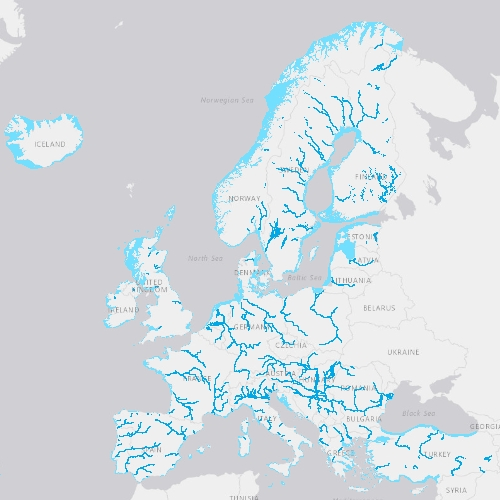50000
Type of resources
Available actions
Topics
INSPIRE themes
Keywords
Contact for the resource
Provided by
Years
Formats
Representation types
Update frequencies
status
Scale
Resolution
-

EU-Hydro is a dataset for all EEA39 countries providing photo-interpreted river network, consistent of surface interpretation of water bodies (lakes and wide rivers), and a drainage model (also called Drainage Network), derived from EU-DEM, with catchments and drainage lines and nodes. EU-Hydro Coastal Line is a separate layer extracted from EU-Hydro. The production of EU-Hydro public beta and the derived layers was coordinated by the European Environment Agency in the frame of the EU Copernicus programme.
-

EU-Hydro is a dataset for all EEA39 countries providing photo-interpreted river network, consistent of surface interpretation of water bodies (lakes and wide rivers), and a drainage model (also called Drainage Network), derived from EU-DEM, with catchments and drainage lines and nodes. The production of EU-Hydro public beta and the derived layers was coordinated by the European Environment Agency in the frame of the EU Copernicus programme.
-

EU-Hydro is a dataset for all EEA39 countries providing photo-interpreted river network, consistent of surface interpretation of water bodies (lakes and wide rivers), and a drainage model (also called Drainage Network), derived from EU-DEM, with catchments and drainage lines and nodes. The production of EU-Hydro and the derived layers was coordinated by the European Environment Agency in the frame of the EU Copernicus programme.
-

EU-Hydro is a dataset for all EEA39 countries providing photo-interpreted river network, consistent of surface interpretation of water bodies (lakes and wide rivers), and a drainage model (also called Drainage Network), derived from EU-DEM, with catchments and drainage lines and nodes. The production of EU-Hydro and the derived layers was coordinated by the European Environment Agency in the frame of the EU Copernicus programme.
-

EU-Hydro is a dataset for all EEA38 countries and the United Kingdom providing photo-interpreted river network, consistent of surface interpretation of water bodies (lakes and wide rivers), and a drainage model (also called Drainage Network), derived from EU-DEM, with catchments and drainage lines and nodes. The EU-Hydro dataset is distributed in separate files (river network and drainage network) for each of the 35 major basins of the EEA38 + UK area. The production of EU-Hydro and the derived layers was coordinated by the European Environment Agency in the frame of the EU Copernicus programme.
-

EU-Hydro is a dataset for all EEA39 countries providing photo-interpreted river network, consistent of surface interpretation of water bodies (lakes and wide rivers), and a drainage model (also called Drainage Network), derived from EU-DEM, with catchments and drainage lines and nodes. EU-Hydro river network is divided into 35 basins (covering all EEA39 countries) available in geodatabase format with geometries and attributes (including HYDRO Feature Dataset with 12 Feature Classes in turn): Oder, Elbe, Rhine, Seine, Vistula, Skjern, Loire, Garonne, Rhone, Duero, Ebro, Tajo, Jucar, Guadalquivir, Shannon, Thames, Tweed, Iceland, French Guiana, French Islands, Hondo, Mesima, Tevere, Po, Tirso, Pinios/Bulgaria, Nemunas, Danube, Gota, Angerman, Neva, Kemi, Tana, Vorma, Turkey. The production of EU-Hydro public beta and the derived layers was coordinated by the European Environment Agency in the frame of the EU Copernicus programme.
-

EU-Hydro is a dataset for all EEA38 countries and the United Kingdom providing photo-interpreted river network, consistent of surface interpretation of water bodies (lakes and wide rivers), and a drainage model (also called Drainage Network), derived from EU-DEM, with catchments and drainage lines and nodes. The EU-Hydro dataset is distributed in separate files (river network and drainage network) for each of the 35 major basins of the EEA38 + UK area, in GDB and GPKG formats. The production of EU-Hydro and the derived layers was coordinated by the European Environment Agency in the frame of the EU Copernicus programme.
-

The EEA potential flood prone area extent delineates the area that is flooded once every 100 years, i.e. the probability of flooding is 1% assuming that flooding is unrestricted. The potential flood prone area is comprised of the river channel and floodplain. In reality, the floodplain is split into an active floodplain where flooding still occurs, and former floodplain where flooding is restricted due to flood protection. The former floodplain could be flooded again either if a flood exceeds the capacity of flood protection, or if factors that control the presence of water were removed. These factors include channel and floodplain morphological alterations as well as structural flood protection measures. The spatial coverage of the data set is EEA39 countries.
-

EU-Hydro is a dataset for all EEA38 countries and United Kingdom providing photo-interpreted river network, consistent of surface interpretation of water bodies (lakes and wide rivers), and a drainage model (also called Drainage Network), derived from EU-DEM, with catchments and drainage lines and nodes. This metadata refers to the coastal areas included in the EU-Hydro dataset, merged into a single file. The production of EU-Hydro and the derived layers was coordinated by the European Environment Agency in the frame of the EU Copernicus programme.
-

EU-Hydro is a dataset for all EEA38 countries and United Kingdom providing photo-interpreted river network, consistent of surface interpretation of water bodies (lakes and wide rivers), and a drainage model (also called Drainage Network), derived from EU-DEM, with catchments and drainage lines and nodes. This metadata refers to the EU-Hydro coastline, which is disseminated as one shapefile merged for all 35 basins. The coastline is also included for each basin in the EU-Hydro River Network Database. The production of EU-Hydro and the derived layers was coordinated by the European Environment Agency in the frame of the EU Copernicus programme.
 RUC Geo-Data catalogue
RUC Geo-Data catalogue